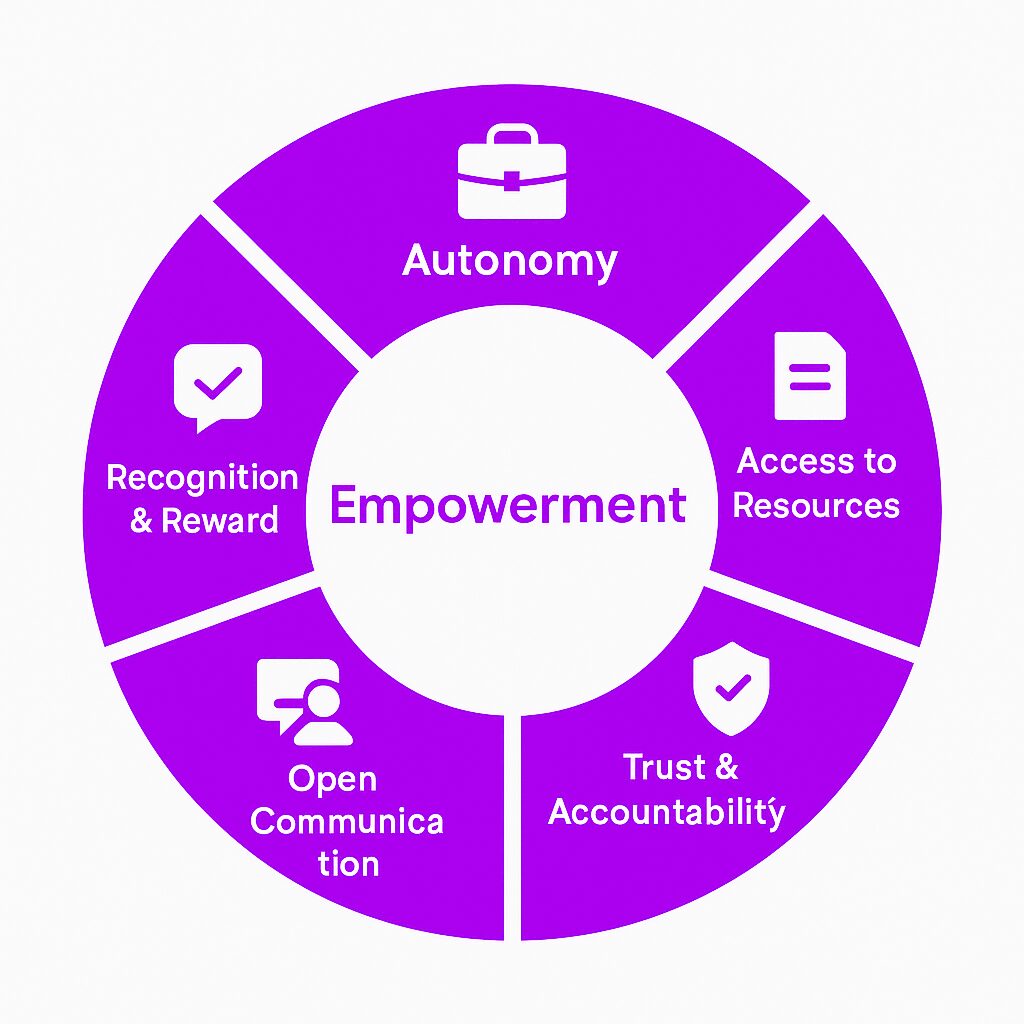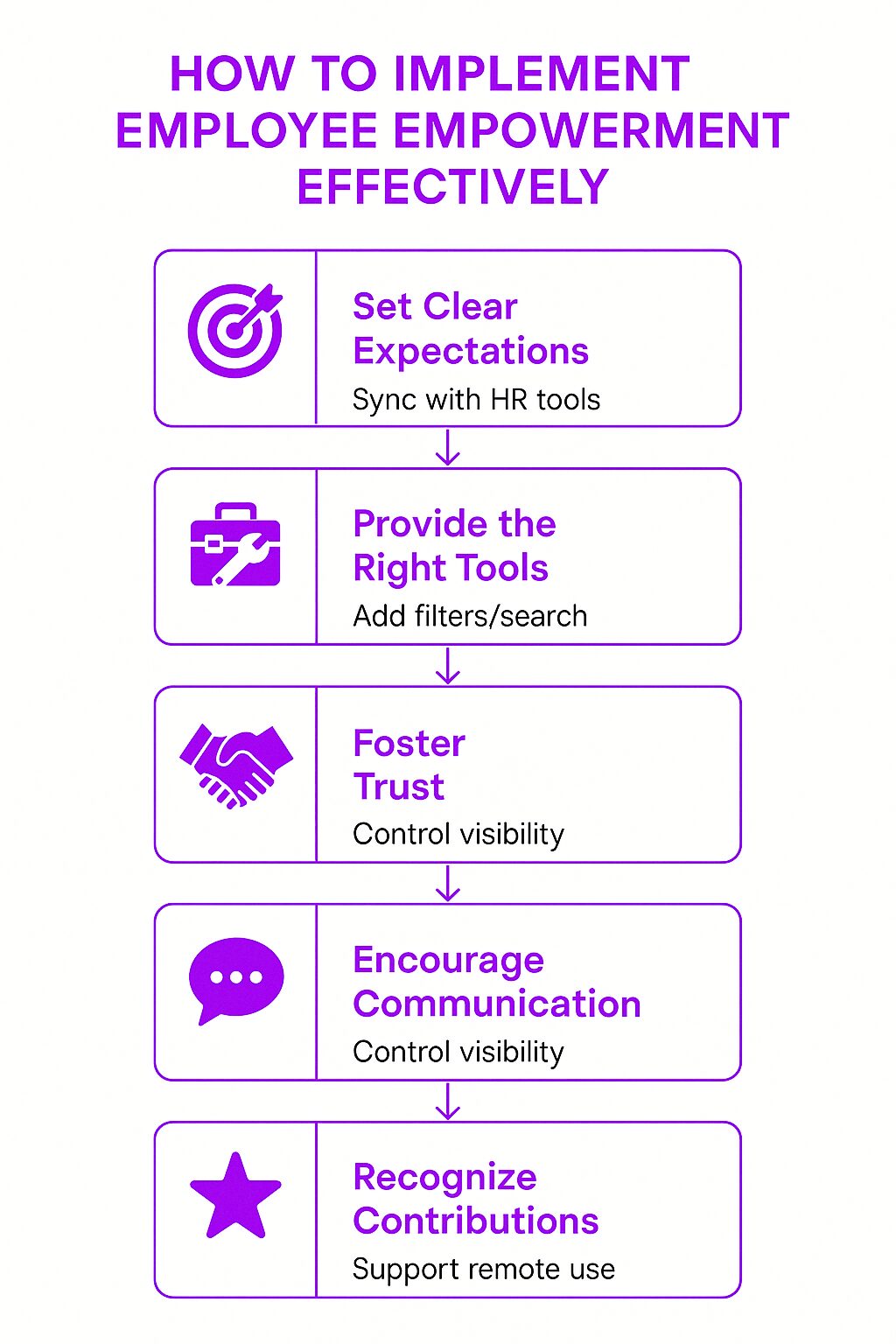What is Employee Empowerment?
Employee empowerment is the process of giving employees more control over their work, decisions, and professional growth. It is not just about delegation; it is about trust. Companies that empower their employees allow them to take initiative, solve problems, and contribute ideas without constant oversight. When employees feel trusted, they are more engaged and productive.
Definition of Employee Empowerment
Employee empowerment is a management philosophy that involves giving employees the autonomy, authority, and resources to make decisions and take actions that benefit the organization. It is a deliberate effort to create a work environment where employees feel valued, trusted, and motivated to contribute their best. Empowering employees involves providing them with the necessary tools, training, and support to perform their jobs effectively and make decisions that align with the company’s goals and objectives.
Why Employee Empowerment Matters
People work better when they feel ownership over their tasks. Empowered employees take responsibility, make informed decisions, and feel more connected to their work. Organizations benefit as well. When employees are trusted to make decisions, work moves faster. Instead of waiting for approvals, teams can act in real time.
Companies with strong empowerment cultures also see lower turnover. A strong company culture centered on empowerment leads to increased employee engagement, motivation, and innovation. Employees are less likely to leave when they feel valued and respected. Empowerment fosters a work environment where individuals take pride in their contributions. This, in turn, enhances employee retention by making employees feel more committed to the organization.
Key Components of Employee Empowerment
Autonomy
Employees should have the freedom to manage their tasks and make decisions within their role. This does not mean working without guidance, but rather, having the flexibility to approach work in a way that makes sense to them.
Access to Resources
Empowerment requires the right tools. Employees need training, technology, and support to succeed. Without these, empowerment is just a buzzword.
Trust and Accountability
For empowerment to work, managers must trust their employees. At the same time, employees must take responsibility for their actions and decisions.
Open Communication
Employees must understand company goals, expectations, and how their work contributes to the bigger picture. Open communication, including regular employee feedback, is essential for fostering transparency. Additionally, incorporating employee input into decision-making not only enhances job satisfaction but also promotes a sense of ownership and connection to the company’s goals. Transparency is essential.
Recognition and Reward
Acknowledging employees who take initiative reinforces the value of empowerment. Recognition can be as simple as a thank-you or as formal as performance-based incentives.
Benefits of Employee Empowerment
Increased Motivation and Job Satisfaction
Motivated employees who feel trusted are more likely to take ownership of their work. This leads to higher engagement and job satisfaction.
Faster Decision-Making
With fewer layers of approval, decisions happen faster. This is particularly useful in customer service, where quick resolutions are essential.
Greater Innovation
Employees who feel empowered are more likely to suggest new ideas. When people believe their input matters, they are willing to take creative risks.
Improved Performance
Empowered employees tend to be more productive because they are not waiting on constant guidance. They know what needs to be done and take action.
Stronger Workplace Culture
A culture of empowerment fosters collaboration, trust, and engagement. Employees work better together when team members feel their contributions matter.
Higher Job Satisfaction
Empowering employees can lead to higher job satisfaction, as they feel more in control of their work and are able to make decisions that impact their job performance. When employees are given the autonomy to make decisions, they are more likely to feel a sense of ownership and accountability for their work, which can lead to increased job satisfaction. Additionally, empowered employees are more likely to feel valued and respected, which can also contribute to higher job satisfaction.
Increased Productivity
Empowering employees can also lead to increased productivity, as they are able to work more efficiently and effectively. When employees are given the autonomy to make decisions, they are able to identify and solve problems more quickly, which can lead to increased productivity. Additionally, empowered employees are more likely to be motivated and engaged, which can also contribute to increased productivity.
Challenges of Employee Empowerment
Lack of Clear Guidelines
Without clear expectations, employees may not know how much freedom they have. Defining boundaries is critical.
Resistance from Management
Some managers struggle to let go of control. They may fear mistakes or believe that employees are not ready for more responsibility.
Need for Training
Not all employees are prepared for autonomy. Training in decision-making, problem-solving, and leadership helps build confidence.
Risk of Mistakes
With greater autonomy comes the risk of errors. Companies must create a culture where mistakes are treated as learning opportunities rather than failures.
Measuring Impact
It can be difficult to quantify the effects of empowerment. Tracking employee satisfaction, employee engagement, retention, and performance metrics can help gauge success.
How to Implement Empowerment Initiatives Effectively
Set Clear Expectations
Define what empowerment means within the organization. Outline roles, responsibilities, and decision-making boundaries.
Provide the Right Tools
Ensure employees have the resources, training, and technology needed to succeed.
Foster a Culture of Trust
Trust is the foundation of empowerment. Managers should demonstrate confidence in their employees’ abilities and decisions.
Encourage Open Communication
Encouraging employees to provide honest feedback and maintaining transparency help them understand their impact and stay aligned with company goals.
Recognize Contributions
Acknowledging and rewarding employees who take initiative reinforces the value of empowerment efforts by recognizing their contributions and establishing clear expectations and boundaries.
Development Opportunities
Providing development opportunities is an important aspect of empowering employees. When employees are given the opportunity to learn and grow, they are more likely to feel valued and motivated. Development opportunities can include training programs, mentorship, and opportunities for advancement. By providing development opportunities, organizations can help employees build new skills and knowledge, which can lead to increased job satisfaction and productivity.
Flexible Hours
Offering flexible hours is another way to empower employees. When employees are given the flexibility to work at times that are convenient for them, they are more likely to feel valued and respected. Flexible hours can also lead to increased productivity, as employees are able to work at times when they are most focused and productive. Additionally, flexible hours can help employees achieve a better work-life balance, which can lead to increased job satisfaction and reduced turnover.
Real-World Examples of Employee Empowerment
Tech Industry
Google’s “20% time” policy allows employees to spend a portion of their workweek on projects they are passionate about. This has led to the creation of products like Gmail and Google Maps.
Retail and Customer Service
Zappos empowers its customer service representatives to make independent decisions, such as offering refunds or upgrades without managerial approval. This has helped build a strong customer-first reputation. Empowering employees works in this context because it allows representatives to address customer needs promptly and effectively, enhancing overall satisfaction.
Remote Work
Companies with remote teams, like Automattic (the company behind WordPress), give employees full autonomy over their schedules and work styles. This trust-based approach has enabled them to attract top talent worldwide.
Healthcare
Hospitals that empower nurses and frontline workers to make decisions in patient care see improved outcomes and higher job satisfaction among staff.
Related Concepts
Employee Engagement
Empowerment and engagement go hand in hand. Involving employees in decision-making enhances engagement by promoting collaboration and autonomy. When employees have control over their work, they are more likely to feel invested in company success.
Servant Leadership
Managers who practice servant leadership focus on supporting and developing their teams rather than simply delegating tasks.
Self-Managed Teams
Some organizations eliminate traditional hierarchies in favor of self-managed teams that operate without direct supervision.
Psychological Safety
For employees to feel empowered, they must feel safe sharing ideas and making decisions without fear of punishment.
Employee empowerment is not a one-size-fits-all strategy. Companies that get it right see better engagement, performance, and retention. It requires a culture of trust, access to resources, and clear communication. When employees feel empowered, they contribute more and drive success for the entire organization.







